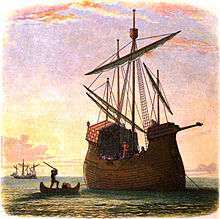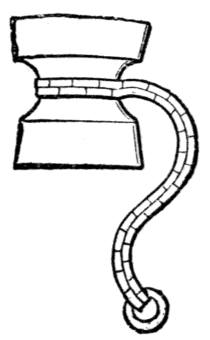William de la Pole, 1st Duke of Suffolk
William de la Pole, 1st Duke of Suffolk, KG (16 October 1396 – 2 May 1450), nicknamed Jackanapes, was an English magnate, statesman, and military commander during the Hundred Years' War. He became a favourite of the weak king Henry VI of England, and consequently a leading figure in the English government. Due to his influence in state policy, Suffolk came to be associated with many of the royal government's failures of the time, particularly on the war in France, earning him significant unpopularity and eventually leading to his downfall. He also appears prominently in Shakespeare's Henry VI, parts 1 and 2.
William de la Pole | |
|---|---|
| 1st Duke of Suffolk | |
 Quartered arms of William de la Pole, Earl of Suffolk, at the time of his installation as a knight of the Order of the Garter | |
| Born | 16 October 1396 Cotton, Suffolk, England |
| Died | 2 May 1450 (aged 53) English Channel (near Dover, Kent) |
| Buried | Carthusian Priory, Hull |
| Spouse(s) | Alice Chaucer (1430–1450, wid.) |
| Issue
John de la Pole, 2nd Duke of Suffolk Jane de la Pole (illegitimate) | |
| Father | Michael de la Pole, 2nd Earl of Suffolk |
| Mother | Katherine de Stafford |
| Military service | |
| Allegiance | |
| Service | 1415–1437 |
| Conflicts |
|
His early career was spent in the military, fighting in the Hundred Years' War from a young age. Despite missing the Battle of Agincourt due to invalidity, he participated in all subsequent campaigns of Henry V,[1] and after the latter's death, Suffolk continued to serve in France, now for the boy king Henry VI. He was one of the English commanders at the failed Siege of Orléans, in the aftermath of which he was taken prisoner (1429). Ransomed shortly after, Suffolk began entering the world of politics. He favoured a diplomatic rather than military solution to the deteriorating situation in France,[1][2] a stance which would later resonate well with King Henry VI.
Following the end of Henry VI's minority (1437), Suffolk became a favoured royal councilor. Gradually building his influence throughout the years, he eventually became the dominant figure in the government, and was at the forefront of the main policies conducted during the period.[3] He played a central role in organizing the Treaty of Tours (1444), which established a truce in France and arranged the king's marriage to Margaret of Anjou. Suffolk benefited greatly from his favour with Henry VI, accumulating lucrative posts, estates, and titles. However, the ultimate failure of his policies, the disastrous renewal of the war in France, and other national problems spelt the destruction of Suffolk's career. Many accused him of maladministration and poor conduct of the war,[3] and political pressures forced Suffolk into exile. At sea on his way out, he was caught by an angry mob, subjected to a mock trial, and beheaded.
His estates were forfeited to the crown but later restored to his only son, John. The de la Pole family was never again to achieve the level of influence Suffolk had enjoyed, however. His political successor was instead the Duke of Somerset, whose enmity with various noblemen, combined with the unstable political climate following the final loss in the Hundred Years' War, led to the Wars of the Roses.
Biography


William de la Pole was born in Cotton, Suffolk, the second son of Michael de la Pole, 2nd Earl of Suffolk by his wife Katherine de Stafford, daughter of Hugh de Stafford, 2nd Earl of Stafford, KG, and Philippa de Beauchamp.
Almost continually engaged in the wars in France, he was seriously wounded during the Siege of Harfleur (1415), where his father died from dysentery.[4] Later that year his older brother Michael, 3rd Earl of Suffolk, was killed at the Battle of Agincourt,[4] and William succeeded as 4th Earl. He served in all the later French campaigns of the reign of Henry V, and in spite of his youth held high command on the marches of Normandy in 1421–22. In 1423 he joined Thomas, Earl of Salisbury in Champagne. He fought under John, Duke of Bedford, at the Battle of Verneuil on the 17th of August 1424, and throughout the next four years was Salisbury's chief lieutenant in the direction of the war.[1] He became co-commander of the English forces at the Siege of Orléans (1429), after the death of Salisbury. When that city was relieved by Joan of Arc in 1429, he managed a retreat to Jargeau where he was forced to surrender on 12 June. He is captured by a French squire named Guillaume Renault. Admiring the young soldier's bravery, the earl decides to knight him before surrendering. This dubbing has remained famous in French history and literature and has been recounted by the writer Alexandre Dumas.He remained a prisoner of Charles VII of France for three years, and was ransomed in 1431, after fourteen years' continuous field service.
After his return to the Kingdom of England in 1434 he was made Constable of Wallingford Castle. He became a courtier and close ally of Cardinal Henry Beaufort. Despite the diplomatic failure of the Congress of Arras, the cardinal's authority remained strong and Suffolk gained increasing influence.[1] His most notable accomplishment in this period was negotiating the marriage of King Henry VI with Margaret of Anjou in 1444, which he achieved despite initial reluctance, and included a two years' truce.[1] This earned him a promotion from Earl to Marquess of Suffolk. However, a secret clause was put in the agreement which gave Maine and Anjou back to France, which was partly to cause his downfall. His own marriage took place on 11 November 1430 (date of licence), to (as her third husband) Alice Chaucer (1404–1475), daughter of Thomas Chaucer of Ewelme, Oxfordshire, and granddaughter of the notable poet Geoffrey Chaucer and his wife, Philippa Roet.
With the deaths in 1447 of Humphrey, Duke of Gloucester, and Cardinal Beaufort, Suffolk became the principal power behind the throne of the weak and compliant Henry VI. In short order he was appointed Chamberlain, Admiral of England, and to several other important offices. He was created Earl of Pembroke in 1447, and Duke of Suffolk in 1448. However, Suffolk was suspected of responsibility in Humphrey's death,[1] and later of being a traitor. On 16 July he met in secret with Jean, Count de Dunois, at his mansion of the Rose in Candlewick street, the first of several meetings in London at which they planned a French invasion. Suffolk passed Council minutes to Dunois, the French hero of the Siege of Orleans. It was rumoured that Suffolk never paid his ransom of £20,000 owed to Dunois. Lord Treasurer, Ralph Cromwell, wanted heavy taxes from Suffolk; the duke's powerful enemies included John Paston and Sir John Fastolf. Many blamed Suffolk's retainers for lawlessness in East Anglia.[5]
The following three years saw the near-complete loss of the English possessions in northern France (Rouen, Normandy etc.). Suffolk could not avoid taking the blame for these failures, partly because of the loss of Maine and Anjou through his marriage negotiations regarding Henry VI. When parliament met in, November 1449, the opposition showed its strength by forcing the treasurer, Adam Moleyns, to resign.[1] Molyns was murdered by the sailors at Portsmouth on 9 January 1450. Suffolk, realizing that an attack on himself was inevitable, boldly challenged his enemies in parliament, appealing to the long and honourable record of his public services.[1] However, on 28 January he was arrested, imprisoned in the Tower of London and impeached in parliament by the commons. The king intervened to protect his favourite, who was banished for five years, but on his journey to Calais his ship was intercepted by the ship Nicholas of the Tower. Suffolk was captured, subjected to a mock trial, and executed by beheading.[6][7] He was later found on the sands near Dover,[8] and the body was probably brought to a church in Suffolk, possibly Wingfield.
Suffolk was interred in the Carthusian Priory in Hull by his widow Alice, as was his wish, and not in the church at Wingfield, as is often stated. The Priory, founded in 1377 by his grandfather the first Earl of Suffolk, was dissolved in 1539, and most of the original buildings did not survive the two Civil War sieges of Hull in 1642 and 1643.[9]
Descendants
Suffolk's only known legitimate son, John, became the second Duke of Suffolk in 1463.
Suffolk also fathered an illegitimate daughter, Jane de la Pole.[10] Her mother is said to have been a nun, Malyne de Cay. "The nighte before that he was yolden [yielded himself up in surrender to the Franco-Scottish forces of Joan of Arc on 12 June 1429] he laye in bed with a nonne whom he toke oute of holy profession and defouled, whose name was Malyne de Cay, by whom he gate a daughter, now married to Stonard of Oxonfordshire".[11] Jane de la Pole (died 28 February 1494) was married before 1450 to Thomas Stonor (1423–1474), of Stonor in Pyrton, Oxfordshire. Their son Sir William Stonor, Kt, was married to Anne Neville, daughter of John, Marquess of Montagu and had two children: John Neville, married to Mary Fortesque, daughter of Sir John Fortesque of Punsburn, Hereford, but died without issue; and Anne Stonor, married to Sir Adrian Fortesque, who distinguished himself at the Battle of the Spurs; he was beheaded in 1539. Thomas Stonor and Jane de la Pole's two other sons were Edward and Thomas. Thomas Stoner married Savilla Brecknock, daughter of Sir David Brecknock.[12] His great-great-grandson Thomas Stoner (18 December 1626 – 2 September 1683) married in 1651 Elizabeth Nevill (born 1641), daughter of Henry, Lord Bergavenny and his second wife Katherine Vaux, daughter of George Vaux and sister of Edward, Lord Vaux of Harrowden.[13] Thomas's son John Stoner (22 March 1654 – 19 November 1689) married on 8 July 1675 Lady Mary Talbot, daughter of Francis, Earl of Shrewsbury and his wife Jane Conyers, daughter of Sir John Conyers.[14]
| Name | Birth | Death | Notes |
|---|---|---|---|
| By Alice (1404–1475), daughter of Thomas Chaucer of Ewelme, Oxfordshire, married 11 November 1430. | |||
| John, 2nd Duke of Suffolk | 27 September 1442 | 1492 | Married 1st Lady Margaret Beaufort (no issue), 2nd Elizabeth of York (had issue) |
| By Malyne de Cay, nun and mistress | |||
| Jane de la Pole | c. Mar 1430 | 28 Feb 1494 | Married Thomas Stonor |
Jackanapes

Suffolk's nickname "Jackanapes" came from "Jack of Naples", a slang name for a monkey at the time. This was probably due to his heraldic badge, which consisted of an "ape's clog", i.e. a wooden block chained to a pet monkey to prevent it escaping.[15] The phrase "jackanape" later came to mean an impertinent or conceited person, due to the popular perception of Suffolk as a nouveau riche upstart; his great-grandfather had been a wool merchant from Hull.
Portrayals in drama, verse and prose
- Suffolk is a major character in two Shakespeare plays. His negotiation of the marriage of Henry and Margaret is portrayed in Henry VI, Part 1. Shakespeare's version has Suffolk fall in love with Margaret. He negotiates the marriage so that he and she can be close to one another. His disgrace and death are depicted in Henry VI, Part 2. Shakespeare departs from the historical record by having Henry banish Suffolk for complicity in the murder of Humphrey, Duke of Gloucester. Suffolk is murdered by a pirate named Walter Whitmore (fulfilling a prophecy given earlier in the play proclaiming he will "die by Water"), and Margaret later wanders to her castle carrying his severed head and grieving.
- His murder is the subject of the traditional English folk ballad "Six Dukes Went a-Fishing" (Roud #78)
- Suffolk is the protagonist in Susan Curran's historical novel The Heron's Catch (1989), plays a role in many of the seventeen Sister Frevisse detective novels of Margaret Frazer, set in England in the 1440s.
- Suffolk is a significant character in Cynthia Harnett's historical novel for children, The Writing on the Hearth (1971)
- Suffolk is one of the three dedicatees of Geoffrey Hill's sonnet sequence, "Funeral Music" (first published in Stand magazine; collected in King Log, Andre Deutsch 1968). Hill speculates about him in the essay appended to the poems.
- Suffolk is one of the main characters in Conn Iggulden's Wars of the Roses: Stormbird, about the end of the Hundred Years' War and the start of the Wars of the Roses.
See also
Footnotes
- Kingsford 1911, p. 27.
- Wagner 2006, p. 260.
- Britannica 1998.
- Bennett 1991, p. 24.
- Curran 2011, pp. 261–2.
- Hicks 2010, p. 68.
- Kingsford 1911.
- Davis 1999, letter 14, pp. 26–29.
- Page 1974, pp. 190–92.
- Richardson 2011, p. 359.
- HMC 1872, pp. 279–280.
- Burke 1835, p. 441.
- Burke 1835, p. 442.
- Burke 1835, p. 443.
- Fox-Davies 1909, p. 469.
References
- Bennett, Michael (23 May 1991). Agincourt 1415: Triumph against the odds. Osprey Publishing. ISBN 978-1-85532-132-8.CS1 maint: ref=harv (link)
- Britannica eds. (20 July 1998). "William de la Pole, 1st duke of Suffolk". Encyclopædia Britannica.CS1 maint: extra text: authors list (link)
- Burke, J. (1835). A Genealogical and Heraldic History of the Commoners of Great Britain and Ireland, 2. London: Henry Colburn.CS1 maint: ref=harv (link)
- Davis, N., ed. (1999). The Paston Letters. Oxford University Press. ISBN 978-0-19-283640-3.CS1 maint: ref=harv (link)
- Fox-Davies, A.C. (1909). . London: T.C. & E.C. Jack.CS1 maint: ref=harv (link)
- Hicks, M. (2010). The Wars of the Roses. Yale University Press. ISBN 978-0-300-11423-2.CS1 maint: ref=harv (link)
- HMC (1872). Third Report of the Royal Commission on Historical Manuscripts. London: Stationery Office. OCLC 223375408.CS1 maint: ref=harv (link)
- Kingsford, C.L. (1896). "Pole, William de la, fourth Earl and first Duke of Suffolk (1396–1450)". Sidney Lee, ed. Dictionary of National Biography. 46. London: Smith, Elder & Co.

- Page, W., ed. (1974). A History of the County of York: Volume 3. Victoria County History.CS1 maint: ref=harv (link)
- Richardson, D. (2011). Kimball G. Everingham (ed.). Magna Carta Ancestry. 4 (2nd ed.). Salt Lake City. p. 144. ISBN 978-1-4609-9270-8.CS1 maint: ref=harv (link)
- Wagner, J.A. (2006). Encyclopedia of the Hundred Years War. Greenwood Press. ISBN 978-0-313-32736-0.CS1 maint: ref=harv (link)
- Watts, J. (2004). "Pole, William de la, first duke of Suffolk (1396–1450)". Oxford Dictionary of National Biography (online ed.). Oxford University Press. doi:10.1093/ref:odnb/22461.CS1 maint: ref=harv (link)
Bibliography
- Curran, Susan (2011). The English Friend. Norwich: Lasse Press. ISBN 978-0-9568758-0-8.CS1 maint: ref=harv (link)
- Fryde, E.B. (1964). The Wool Accounts of William de la Pole: a study of some aspects of the English wool trade at the start of the Hundred Years' War. St. Anthony's Press, Borthwick Institute of Historical Research. ISBN 978-0-900701-26-9.CS1 maint: ref=harv (link)
- Griffiths, R.A. (1981). The Reign of King Henry VI. University of California Press. ISBN 978-0-520-04372-5.CS1 maint: ref=harv (link)
- Richardson, Douglas (2004). Kimball G. Everingham (ed.). Plantagenet Ancestry. Baltimore, MD: Genealogical Publishing Co. ISBN 978-0-8063-1750-2.CS1 maint: ref=harv (link)
- Watts, J. (1996). Henry VI and the Politics of Kingship. Cambridge UP. ISBN 978-0-521-42039-6.CS1 maint: ref=harv (link)
- Williams, E.T.; Nicholls, C.S., eds. (1981). Dictionary of National Biography (8th supplement). Oxford University Press. ISBN 978-0-19-865207-6.CS1 maint: ref=harv (link)
External links
| Political offices | ||
|---|---|---|
| Preceded by The 2nd Duke of Exeter |
Lord High Admiral 1447–1450 |
Succeeded by The 3rd Duke of Exeter |
| Peerage of England | ||
| New creation | Duke of Suffolk (1448) 2 July 1448 – 2 May 1450 |
Succeeded by John de la Pole |
| Marquess of Suffolk (1444) 14 September 1444 – 2 May 1450 | ||
| Preceded by Michael de la Pole |
Earl of Suffolk (1385) 25 October 1415 – 2 May 1450 | |
| Preceded by Humphrey, Duke of Gloucester |
Earl of Pembroke (1447) 23 February 1447 – 2 May 1450 |
Forfeit |